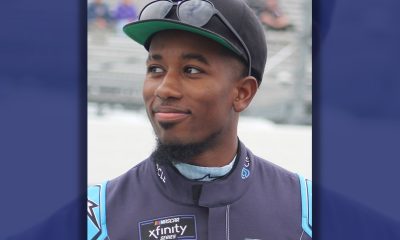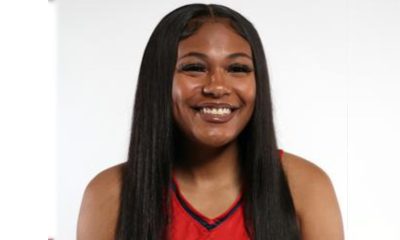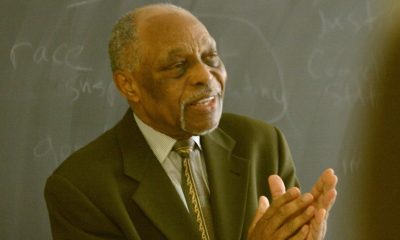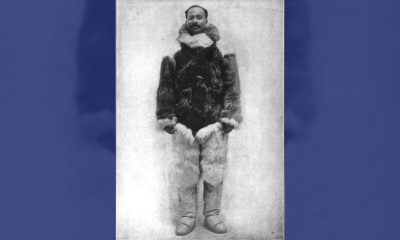Black History
Overlooked History Made at NCAA Final Four
THE TENNESSEE TRIBUNE — There was some overlooked history made at this year’s NCAA Final Four. It wasn’t just that Virginia finally won an NCAA men’s title, or that they went from being the first number one seed to lose to a 16th seed one season and then the next year become a champion. No, the real history came at the top of the ladder for the respective schools. Both Virginia and Auburn, who played a thrilling one-point semifinal game decided on a controversial call, had Black athletic directors.
By Ron Wynn
There was some overlooked history made at this year’s NCAA Final Four. It wasn’t just that Virginia finally won an NCAA men’s title, or that they went from being the first number one seed to lose to a 16th seed one season and then the next year become a champion. No, the real history came at the top of the ladder for the respective schools. Both Virginia and Auburn, who played a thrilling one-point semifinal game decided on a controversial call, had Black athletic directors.
Allen Greene is Auburn’s AD. Carla Williams is Virginia’s, and she became the first Black woman to preside over an NCAA men’s basketball champion. The NCAA should have been advertising that news all over the place, because otherwise things don’t look very good for them when it comes to diversity and inclusion, even in a sport with as many Black players as basketball.
There are ZERO Black head coaches in both the Big Ten and Pac 12. There are two in the Big 12 and SEC, with Vanderbilt’s hiring of Jerry Stackhouse being the reason for that. The ACC leads all Power conferences with three. The numbers are even worse when it comes to Black women head coaches.
There are ZERO in the Big 12. A grand total of ONE in the ACC, the Big Ten and Pac-12. The SEC has everyone beat on this end with four. There is general agreement that these numbers are abysmal in 2019, but there’s no consensus about what can be done to improve them. Kentucky’s John Calipari told ESPN’s The Undefeated website that more top white coaches were going to have to stand up and be counted on this issue for things to change.
“We don’t have enough guys who are willing to stand up and say stuff that needs to be said,” Calipari said. NCAA president Mark Emmert added his voice to that sentiment, saying, “I think those folks (influential white head coaches) can have a huge impact. If you’ve got candidates out there, men of color, let’s say, going after men’s basketball positions and a coach of the stature of Tom (Izzo) or Cal or any of those guys are willing to give them a seal of approval, saying, ‘You know. you hire this guy, I promise you, you’re going to have a good coach. You will have no regrets,’ that screws up somebody’s courage a lot. They have a lot of stroke in this process if they chose to exercise it.”
But another factor that must be added is the lack of Black athletic directors at Power conferences. Currently there are just 10. It is no accident that with Malcolm Turner at Vanderbilt the school has Blacks as both head football and basketball coaches. Turner has already twice gone against conventional wisdom in giving Derek Mason an extension and hiring an unproven person in Jerry Stackhouse, at least on the college level, rather than just another retread person.
You never know, but it’s doubtful a white AD would have made either of those hiring decisions at Vanderbilt. Unfortunately, that’s still the case too often at many colleges and universities.
This article originally appeared in The Tennessee Tribune.
Activism
Oakland Post: Week of May 8 – 14, 2024
The printed Weekly Edition of the Oakland Post: Week of May May 8 – 14, 2024

To enlarge your view of this issue, use the slider, magnifying glass icon or full page icon in the lower right corner of the browser window. ![]()
Activism
S.F. Black Leaders Rally to Protest, Discuss ‘Epidemic’ of Racial Slurs Against Black Students in SF Public School System
Parents at the meeting spoke of their children as no longer feeling safe in school because of bullying and discrimination. Parents also said that reported incidents such as racial slurs and intimidation are not dealt with to their satisfaction and feel ignored.

By Carla Thomas
San Francisco’s Third Baptist Church hosted a rally and meeting Sunday to discuss hatred toward African American students of the San Francisco Unified School District (SFUSD).
Rev. Amos C. Brown, president of the San Francisco NAACP and pastor of Third Baptist Church, along with leadership from local civil rights groups, the city’s faith-based community and Black community leadership convened at the church.
“There has been an epidemic of racial slurs and mistreatment of Black children in our public schools in the city,” said Brown. “This will not be tolerated.”
According to civil rights advocate Mattie Scott, students from elementary to high school have reported an extraordinary amount of racial slurs directed at them.
“There is a surge of overt racism in the schools, and our children should not be subjected to this,” said Scott. “Students are in school to learn, develop, and grow, not be hated on,” said Scott. “The parents of the children feel they have not received the support necessary to protect their children.”
Attendees were briefed last Friday in a meeting with SFUSD Superintendent Dr. Matt Wayne.
SFUSD states that their policies protect children and they are not at liberty to publicly discuss the issues to protect the children’s privacy.
Parents at the meeting spoke of their children as no longer feeling safe in school because of bullying and discrimination. Parents also said that reported incidents such as racial slurs and intimidation are not dealt with to their satisfaction and feel ignored.
Some parents said they have removed their students from school while other parents and community leaders called on the removal of the SFUSD superintendent, the firing of certain school principals and the need for more supportive school board members.
Community advocates discussed boycotting the schools and creating Freedom Schools led by Black leaders and educators, reassuring parents that their child’s wellbeing and education are the highest priority and youth are not to be disrupted by racism or policies that don’t support them.
Virginia Marshall, chair of the San Francisco NAACP’s education committee, offered encouragement to the parents and students in attendance while also announcing an upcoming May 14 school board meeting to demand accountability over their mistreatment.
“I’m urging anyone that cares about our students to pack the May 14 school board meeting,” said Marshall.
This resource was supported in whole or in part by funding provided by the State of California, administered by the California State Library via California Black Media as part of the Stop the Hate Program. The program is supported by partnership with California Department of Social Services and the California Commission on Asian and Pacific Islander American Affairs as part of the Stop the Hate program. To report a hate incident or hate crime and get support, go to CA vs Hate.
Activism
Oakland Post: Week of May 1 – 7, 2024
The printed Weekly Edition of the Oakland Post: Week of May 1 – 7, 2024

To enlarge your view of this issue, use the slider, magnifying glass icon or full page icon in the lower right corner of the browser window. ![]()
-

 Community3 weeks ago
Community3 weeks agoFinancial Assistance Bill for Descendants of Enslaved Persons to Help Them Purchase, Own, or Maintain a Home
-

 City Government6 days ago
City Government6 days agoCourt Throws Out Law That Allowed Californians to Build Duplexes, Triplexes and RDUs on Their Properties
-

 Activism2 weeks ago
Activism2 weeks agoOakland Post: Week of April 24 – 30, 2024
-

 Business3 weeks ago
Business3 weeks agoV.P. Kamala Harris: Americans With Criminal Records Will Soon Be Eligible for SBA Loans
-

 Activism4 weeks ago
Activism4 weeks agoOakland Post: Week of April 10 – 16, 2024
-

 Community3 weeks ago
Community3 weeks agoAG Bonta Says Oakland School Leaders Should Comply with State Laws to Avoid ‘Disparate Harm’ When Closing or Merging Schools
-

 Community3 weeks ago
Community3 weeks agoRichmond Nonprofit Helps Ex-Felons Get Back on Their Feet
-

 Community3 weeks ago
Community3 weeks agoOakland WNBA Player to be Inducted Into Hall of Fame















































